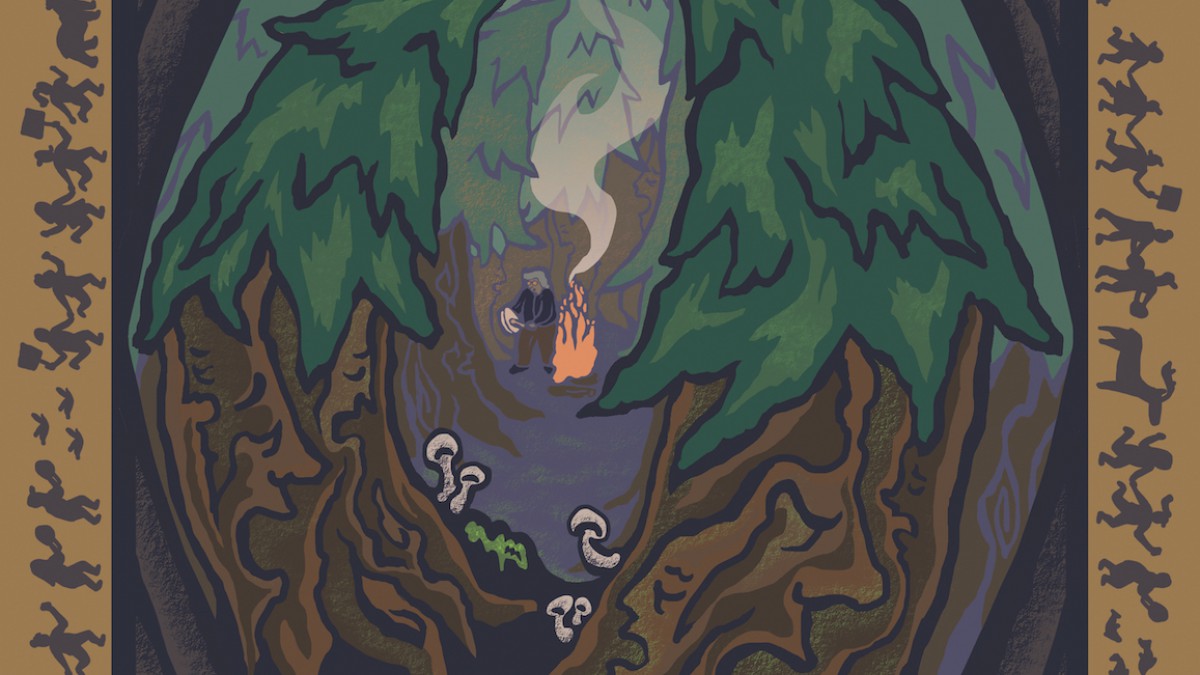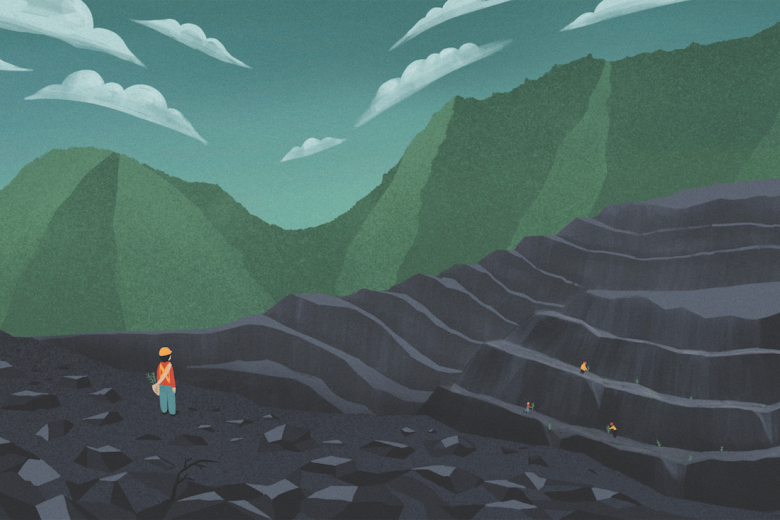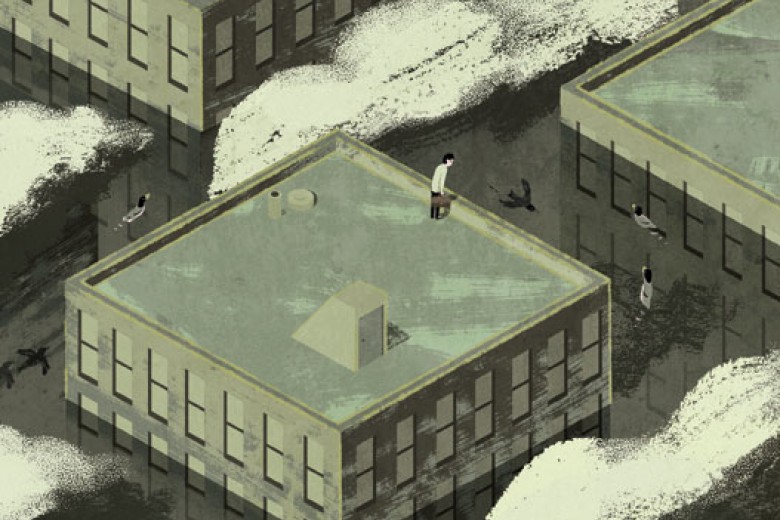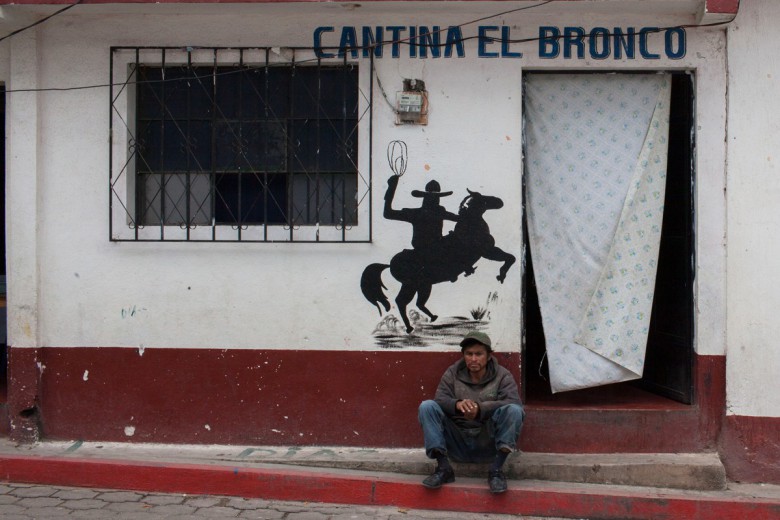“11 a.m. is the best time to be in an old-growth forest, the light is just beginning to filter through the canopy,” Deric tells me.
Dusk had fallen, and our silhouettes were illuminated by the faint glow of Deric’s cigarette and a bonfire in the distance. We stood in the middle of a logging road that led into Caycuse Valley, where Teal-Jones was set to log ancient forests on Ditidaht land. But earlier that week, workers were abruptly stopped by members of the Rainforest Flying Squad. With haste and urgency that only looming extinction can fuel, activists erected roadblocks and the Caycuse camp in less than a few days.
“You know, these forests are dead,” Deric says, waving his arm at the swath of monocrop stands of fir trees that resemble matchsticks, seeded by tree planters to replace what had been a biodiverse ancient forest. “At this time of the evening, it should sound like an orchestra,” he explains, referring to the birds and the multitude of animals whose homes are bound to old-growth forests. We both pause and listen. Except for the crackling fire and the faint murmur of conversations, it was silent.
“The fact that they’re the last of the old growth – all the last of our spiritual freedom that we have in this world.”
Today, less than 3 per cent of the most productive and biologically rich old-growth forests remain in British Columbia, yet these endangered forests are still being logged across the province at the staggering rate of more than 500 soccer fields per day. Nearly 94 per cent of British Columbia’s land base is provincially controlled Crown land, stolen Indigenous lands. Close to 53 million hectares of Crown land is managed by the Ministry of Forests, Lands, Natural Resource Operations and Rural Development and classified as productive forest land – which means the provincial government can, at least in theory, determine what the land is used for, and the rate at which it is logged. On Vancouver Island, ancient forests are destroyed three times faster than the Amazon rainforest, according to Sierra Club B.C.
After a century of colonialism and capitalism fanning the flames of corporate abuse and environmental degradation, the movement to save the last stands of old-growth forests in British Columbia is growing exponentially. In August of 2020, land defenders and a Pacheedaht Elder, Bill Jones, caught word that Teal Jones would begin building roads and logging ancient forests in the pristine Ada’itsx Fairy Creek watershed in a remote part of southwest Vancouver Island, where some trees are up to a thousand years old. Galvanized by the dire threats these endangered ecosystems face, activists began the Ada’itsx Fairy Creek Blockades, calling themselves the Rainforest Flying Squad.
Indigenous Peoples have stewarded ancient forests since time immemorial; their culture, language, and identity are inextricably bound to these ancient giants. As Elder Bill Jones told the Watershed Sentinel, “The fact that they’re the last of the old growth – all the last of our spiritual freedom that we have in this world.”
"It has everything to do with what is beneath the soil, what is being carried by the water, what is the entire cycle of life that exists on these territories.”
While overlooking the Caycuse Valley as ancient cedars were felled by loggers, I speak with xʷ is xʷ čaa, whose English name is Kati George-Jim. They explain the ways in which the grassroots movement for old growth goes beyond big-tree activism. “As much as this fight is about old-growth logging, it is so much deeper than just an industry. It’s so much deeper than one singular forest, one singular tree, or organism of any sort. It has everything to do with what is beneath the soil, what is being carried by the water, what is the entire cycle of life that exists on these territories.”
They continue: “That includes our relationship to the land and how we get to practise who we are as quuʔas, as coastal people, and how, as relatives, we need to stand for each other’s territories and stand against colonialism invading people’s territories for the sake of a very small profit in comparison to the actual value of the land, the value of our ancestors, the value of our culture, and language, and spirituality.”
For over a year, in what has become the largest civil disobedience movement in Canadian history, Fairy Creek land defenders have continued to hold off logging operations that would finish off these ancient trees that predate colonialism and capitalism.
The alarming state of B.C. forestry is the direct result of those two systems. It can be traced to the “domination of the land base by a powerful and increasingly concentrated forest industry,” writes author Jeremy Wilson in Talk and Log. He calls B.C. “a province where speculative capitalism reigned supreme and where trafficking in land and rights to natural resources had contributed significantly to most of the great private fortunes.” The forestry tenure system, which grants timber harvesting rights through renewable 25-year tree farm licences (TFL), perpetuates corporate hegemony. Just five companies hold half of all the timber harvesting rights in B.C.
The existence of these ancient forests challenges the ideology of capitalism and colonialism, systems that necessitate individualism and conquest for material gain.
The forestry regime follows a fundamentally colonial model, in which forest lands are treated as terra nullius. The assumption is that nature is capital, a resource to be managed for society’s perpetual economic benefit. This idea is implicit in B.C.’s forestry policy and history, most notably in the policy of sustained yield. Sustained yield is based on the concept that old-growth forests are an asset to be converted into tree farm plantations, managed by science, to yield timber resources in perpetuity. It leads to forest management regimes that involve stripping forests bare, then replacing them with monocrop tree farms devoid of “competing” vegetation. This intensive tree farming system, designed to maximize timber yield, removes the very biodiversity that makes the forests so rich in the first place.
The B.C. government continues to view forests primarily as a source of timber rather than a collective lifeline for the planet. Despite Premier John Horgan having promised a “paradigm shift” in its approach to managing old growth, the government has not adequately implemented the recommendations from the province’s Old Growth Strategic Review panel report released last year, which included logging deferrals in places with very little old-growth forest remaining. B.C. politicians are engaging in what many call a "talk and log” scenario. B.C. Timber Sales, the government’s own logging agency, itself auctions off some of the best remaining old-growth forests in the province. According to the Wilderness Committee, the provincial government approved 40 per cent more old-growth logging last year than the year before.
Impeding public understanding by limiting access to information is like slipping sedatives to the public. Corporations and governments have engaged in decades of denial and misinformation campaigns to normalize the annihilation of critical ecosystems. Wilson recounts that during the 1990s, industry spokesperson Patrick Moore argued that “clearcutting should not be equated with deforestation; clearcut areas are simply ‘temporary meadows’ and are alive with a diversity of species” and that “clearcut forestry often increases species and landscape diversity.”
Today, denialism takes many forms. The provincial government claims that about a quarter of the province’s forests are old growth, but most of this area is what scientists call “low productivity” old growth: bog and subalpine forests that grow small trees slowly. In actuality, scientists have found that less than 1 per cent of B.C.’s forests are “high productivity” old growth – areas with large trees that sequester carbon and support high biodiversity and ecosystem resilience. Summarizing their findings, scientists wrote: “We question recent reviews of forest policy that conclude that BC represents a ‘best practice model’ for sustainable forest management.”
He calls B.C. “a province where speculative capitalism reigned supreme and where trafficking in land and rights to natural resources had contributed significantly to most of the great private fortunes.”
Recent studies have shown B.C.’s forests are the largest emitters of greenhouse gases in the province, producing a staggering 23 per cent more emissions than the energy sector. According to the Wilderness Committee, “Between 1990 and 1994, forests across B.C. absorbed an average of more than 45 million tonnes of CO2 from the atmosphere each year. But in 2003, forests in the province switched from being net absorbers of CO2 to net emitters.” This is because “when the trees are cut down, up to 46 per cent of the carbon in a forest is lost through waste and residue.” As a result, “between 2014—2018, [B.C.’s forests] released more than 30 million tonnes on average. This doesn’t even include emissions from wildfires.”
However, in forest policy updates and briefings, the government hardly mentions carbon emissions and has excluded counting emissions from forests. Canada’s entire managed forests create more pollution than they absorb, according to David Broadland. According to journalist Michelle Gamage, who reached out to the Ministry of Environment for comment, the ministry claimed the change in forests’ capacity for carbon sequestration was due to pine beetle-caused die-offs and climate change rather than being a result of rampant old-growth logging and deforestation through government and corporate actions. Further, as reported by Emma Gilchrist for The Narwhal, the 429-page Preliminary Strategic Climate Risk Assessment for British Columbia does not examine how industrial logging contributes to climate risks, though it does consider the ways in which climate change would impact the profitability of the industry.
This is climate denialism, absolving corporations and governments of blame for fuelling climate change and destroying what little remains of intact forests in British Columbia. B.C’s efforts to maintain the legitimacy of archaic, destructive forestry management practices are criminal amid a worsening climate crisis.
He told me that what scares him most is the public’s shifting perception of a forest; to him, the monocrop tree farms that replace ancient forests are not “forests.”
Two years ago, I joined the Wilderness Committee for a trail build in the kaxi:ks, also known as the Walbran, an intact old-growth forest on Pacheedaht territories slated for logging by Teal-Jones. We built boardwalk trails throughout proposed cutblock sites to bring the public into the forest, with the hope that a deeper connection to the forests would elicit a sense of responsibility to protect them. While drilling bridge poles with a veteran of the “War in the Woods” – the 1993 Clayoquot Sound protests – I asked him how he felt returning to another threatened forest, decades after first protesting old-growth logging. He told me that what scares him most is the public’s shifting perception of a forest; to him, the monocrop tree farms that replace ancient forests are not “forests.” He witnessed that once old growth was logged, second-growth and tree farms became normalized as forests, rather than what should be intact biodiverse ancient old-growth forests. He fears that ongoing pillaging of old-growth trees will one day render them a fable, a mythic relic of the past.
Old-growth forests can remind humanity of a time before capitalism and colonialism. These ancient trees – bound by an earthen ecosystem of reciprocity that has taken thousands of years to become what it is today – are a testament to the abundance that comes from a collectivized, relational world. The existence of these ancient forests challenges the ideology of capitalism and colonialism, systems that necessitate individualism and conquest for material gain. In the movement to save ancient forests, we can remember our way forward into a future that honours Indigenous Rights, stewardship, and collective reverence for these last stands of biodiversity.
“Productive old forests are naturally rare in B.C. […] These ecosystems are effectively the white rhino of old growth forests. They are almost extinguished and will not recover from logging,” scientists write in “BC’s Old Growth Forests: A Last Stand for Biodiversity,” a 2020 report. At the current rate of logging, without immediate action, almost all of the remaining unprotected at-risk old growth will be logged within a few years. We are in a race against corporate abuse to protect land untouched by capitalism: ancient forests as a thriving, sovereign entity.







